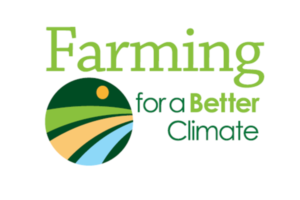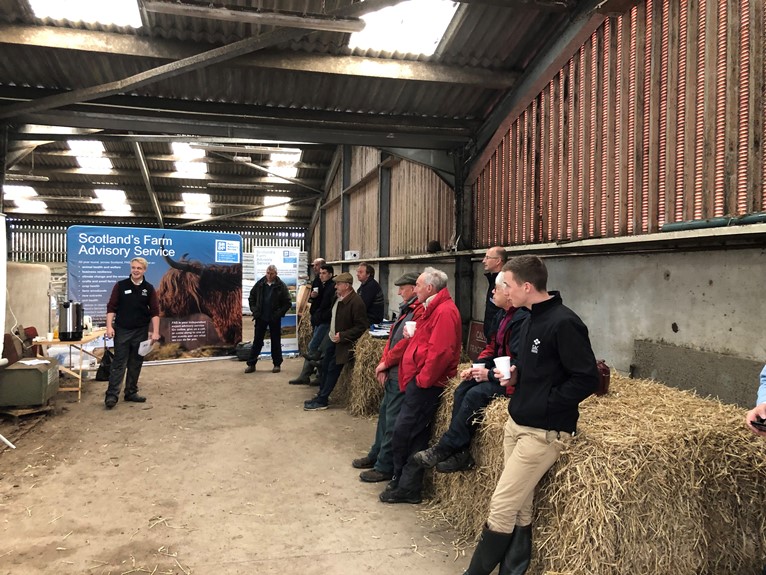Stirling Soil & Nutrient Network: Final Meeting – event summary
30 October 2019The final meeting of the Stirling Soil & Nutrient Network was held earlier this month on our host farm, Aucheneck.
The previous meetings have been fantastic with over 20 farmers involved the group. Campbell Graham has been a terrific host and we have enjoyed his contributions and opinions to these meetings. The final meeting seemed to top them all. Although down on numbers the sessions and practical demonstrations on the day suited the group, with a good interaction on the topical issues.
Nitrogen
Donald Dunbar took us through a whistle-stop tour of Nitrogen Management! He revealed the complexity of the Nitrogen element, in that it exists in different forms: ‘Readily available’, ‘Organic’ and Crop available’. Therefore, it is not so easy to accurately test for in a soil sample. Other factors must be considered when calculating a crops N requirement, these include previous cropping, type of fertiliser applied and application timings.
Donald concluded that good nitrogen management:
- reduces losses into the environment
- improves the efficiency of crop response to available nitrogen
- enhances profits
- reduces greenhouse gas emissions
Trace elements
Moving onto other elements required for efficient crop production, Robin Mair revealed how offtakes of P and K silage are high with multiple silage cuts. A sample of silage at Aucheneck (2nd cut silage 12t/ha) removed 1.7kg/t of P and 6kg/t of K. Robin’s key message was to replace the offtakes with the known contents of mineral fertiliser or organic manures.
Robin also spoke on how trace elements often get the blame for underperforming growth in cattle, however, often poor energy (ME) or protein in a ration is responsible. To know if you’re at risk of trace element deficiency you should know your soil type, ensure that soil pH is at the correct level; that the field drainage system is sound, and analyse your forage. Blood sampling can also be useful. Your local agricultural consultant will be able to help you if you think this is an issue.
Like with nitrogen, the interaction of micro soil minerals and plant uptake is a complex process. It is not the case that copper, cobalt, iodine and selenium can be easily transferred into the animal from the soil; mineral uptake is complex. Therefore, if testing for trace mineral deficiency in many cases you should test a herbage sample, not a soil sample.
Climate Change
The final topic was brought by Zach Reilly who engaged with the farmers and spoke about the topic of climate change. A key point from his presentation was to look at the IPCC figures ( and not any other secondary sources) for the average carbon emission  produced from different sectors. There was an interest in Carbon Audits after Zach’s session. The consensus was that everyone did want to know the emissions produced from their own farm business. Zach pointed out that changes in management don’t have to be drastic because, as in the case of the Farming For a Better Climate – Climate Change Focus Farms, large carbon savings can be made without changing the current land use. Zach mentioned the key findings at Aucheneck e.g. reducing compaction, increasing soil organic matters, and making use of the one-pass systems.
produced from different sectors. There was an interest in Carbon Audits after Zach’s session. The consensus was that everyone did want to know the emissions produced from their own farm business. Zach pointed out that changes in management don’t have to be drastic because, as in the case of the Farming For a Better Climate – Climate Change Focus Farms, large carbon savings can be made without changing the current land use. Zach mentioned the key findings at Aucheneck e.g. reducing compaction, increasing soil organic matters, and making use of the one-pass systems.
Conclusions
It has been established that the relationships between soil and nutrients are complex, but not above our intellect. With a little bit of ‘digging,’ we can understand our soils and in turn farm in a much more sustainable and profitable manner.
Our host farm, Aucheneck, has undergone many changes since the start of the project e.g. introduction the implementation of rotational farming; investing in a lime spreader to ensure that a lime management plan is implemented on an annual basis; and the use of a soil aerator accompanied by the use of smaller tractors with wider tyres is helping reducing compaction. The Campbell family’s reasons for these changes is because ‘by looking after the soil then the soil will look after you’.
It has been a worthwhile experience at Aucheneck with many lessons learned for all of those who participated in the Soil & Nutrient Network; hopefully, some of the lessons and tips acquired by those who attended the events will be implemented across the local farms.
Copies of the presentation slides during the event and the delegate pack information is available to take home on the day are available to download from the links below.
- Practical Guide: Greenhouse Gas Emissions
- This Practical Guide looks at the main agricultural greenhouse gases and how farm emissions might be reduced.
- Topics: Climate Change
- A Report on Soil and Organic Materials Analysis from the Soil and Nutrient Network Farms 2016 – 2018
- Stirling Soil & Nutrient Network – Final Meeting presentation slides, Jack Munro
- These presentation slides were used by Jack Munro who chaired the final meeting of the Stirling Soil & Nutrient Network at Aucheneck in early October 2019
- Topics: Soils
- Stirling Soil & Nutrient Network: Nitrogen Management – Donald Dunbar
- Presentation slides used by Donald Dunbar during the final meeting of the Stirling Soil & Nutrient Network, focusing on managing Nitrogen on the farm.
- Topics: Soils
- Stirling Soil & Nutrient Network: Crop & Soil analysis – Robin Mair
- Presentation slides used by Robin Mair during the final meeting of the Stirling Soil & Nutrient Network, focusing on crop and soil analysis.
- Topics: Soils
- Stirling Soil & Nutrient Network – Climate Change: presentation slides used by Zach Reilly
- These are the presentation slides used by Zach Reilly to discuss Climate Change with farmers who attended the final meeting of the Stirling Soil & Nutrient Network.
- Topics: Soils
- Soil & Nutrient Network: Case Study – Aucheneck Estates, Stirling
- Aucheneck Estates are farming at Aucheneck with the nearby units of Hillhead of Catter, Shandon Drymen, Gallangard and Cairnlea, totalling some 1,915ha which is all rough grazing and permanent grassland.
- Topics: Soils
Sign up to the FAS newsletter
Receive updates on news, events and publications from Scotland’s Farm Advisory Service

